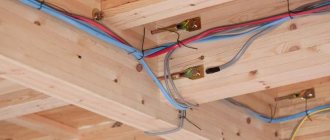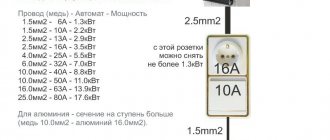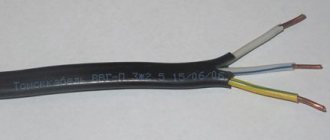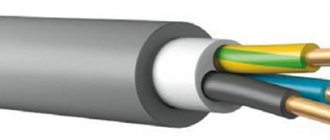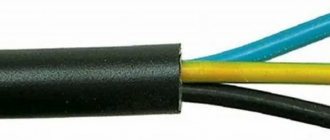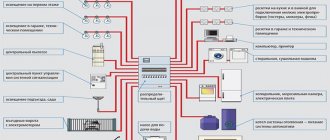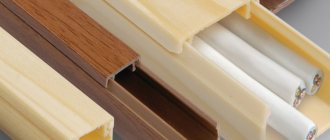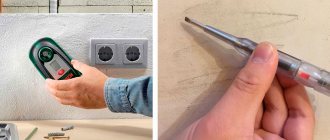To properly organize the supply of electricity during construction or renovation, you need to know which wire to use for wiring in the house. It is better to entrust the installation of the power supply network to a specialist, but you can purchase materials yourself. To do this, you need to remember the basic rules for choosing a cable correctly.
What are electrical cables made of?
The main conductor of electric current is aluminum or copper conductors. The larger their diameter, the higher the cable's capabilities.
Aluminum wires are cheaper, but they are more likely to deteriorate and have a lower electrical conductivity coefficient.
Copper cable is durable, does not break at bends and is capable of carrying more current than aluminum cable with the same diameter.
It is recommended that all wiring in the house be of the same type. This is due to the fact that to connect products from different materials, a special adapter will be required so as not to create a galvanic couple. In this case, oxidation and destruction of the wires occurs, which can lead to a short circuit.
The main cores are covered in braids made of rubber, polyethylene or PVC. Often several of these insulated conductors are combined into a bundle, which in turn is covered with a protective sheath.
General principles for installing a spotlight
According to existing norms and standards, the wiring for such lamps is hidden directly in the thickness of the wall. This approach allows you to get rid of hanging wires that visually “clutter” the interior space of the room. However, you should not only accurately calculate the location of the wire, but also document it in any convenient way.
In order to make a groove for laying the power wire, you will need a hammer drill or drill with an impact bit. The thickness of the gutter should be about several centimeters, since some models of spotlights are equipped with a thick cable.
There are situations when the wire length is not enough to power the lighting source. It is not recommended to make “homemade” products and connect several wires into one. Specialized stores sell cables of various lengths, so you should use a ready-made option. If you decide to use this option, make sure that the connection is working and that the connection has been isolated.
Types of wiring
The choice of the required wire depends on the type of installation, because The installation method affects the requirements.
Open
Open cabling is the laying of cables directly along building structures. It is produced where there is no possibility or need to hide wiring in the wall or ceiling.
Since an openly laid cable is not protected by anything, it is necessary to protect it from mechanical damage. In addition, for safety reasons, it is recommended to use a wire with a core cross-section of at least 4 mm².
Hidden
To install hidden wiring, a groove is punched in the wall in which the cable is laid, and then it is sealed and covered with plaster. With this method of power supply, less stringent requirements are imposed on the wire, because it is isolated both from external influences and from the effects of overheating.
The requirements for the home electrical network are regulated by the PUE clause 7.1.34.
Deciding on the installation location
Absolutely any type of construction work must begin with careful planning on paper or in another accessible way. Many customers prefer to save on expense items, so after some of the work has been completed, defects and shortcomings are visible.
If we are talking about installing spotlights, then there is a list of common places where they are most often installed:
- Above the berth;
- Above the work area;
- In the relaxation area and reading area;
- In the kitchen or room above the tables.
Installing a chandelier is different from installing spotlights - they do completely different things that seem similar from the outside. For a spotlight, the wiring can be routed directly from the distribution panel in the house or apartment. You can also power this type of lighting from an outlet.
Difference between cable and wire
The wire is a lightweight structure consisting of 1-3 insulated cores. It is less secure than cable and has a simpler internal structure.
A cable is a wire of a more complex structure. In addition to several cores separated from each other, it has a double layer of insulation, a gasket, a screen and is recommended for use in residential areas.
Rules for choosing a cable for wiring in the house
The selected cable must comply with the following rules:
- Ensure the required level of electrical and fire safety.
- Provide the ability to simultaneously turn on several household appliances and lighting.
- Allow quick and convenient installation.
Initially, the rules of the PUE, clause 7.1.34, allowed the use of only cables with copper conductors in residential premises, except for houses whose construction began before 2001. However, later these requirements were excluded.
However, when choosing home electrical wiring, you must remember that to combine aluminum and copper conductors, you need special adapter clamps that prevent contact of dissimilar metals.
When choosing means for home electrical wiring, it is necessary to determine the material of the cores and their cross-section. When purchasing, first of all, check the labeling and availability of certificates. The quality of the cable products offered does not always meet the standards, so it is better to purchase them from reputable manufacturers.
Marking
The wires are marked on the braid. The letter designation is followed by a series of numbers.
If the cable brand begins with the letter A (for example, AVVG), then its cores are made of aluminum. Otherwise, the conductors are copper. The following letters indicate the material from which the outer and inner braids are made:
- B (Вр) - polyvinyl chloride;
- P (Ps) - polyethylene;
- C - lead.
The numbers indicate the number of cores and the cross-sectional area of each of them.
For example, the name of the most common cable for internal wiring VVG-0.66 kV 3x1.5 means the presence of 3 cores with a cross-section of 1.5 mm² each, enclosed in a polyvinyl chloride sheath, with the same external insulation.
The designation 0.66 kV indicates that the product is used in networks up to 660 V.
If the marking has the letters “ozh”, the conductors are single-wire, i.e. whole.
Section calculation
To determine the required wire cross-section, you should estimate the maximum load of the electrical network. This can be done by knowing the power consumption of the connected devices. It is indicated in the instructions, passports or on the housing of the devices themselves.
Serial connection
You can connect spotlights in series, although this is not the best solution. Despite the fact that this type of connection requires a minimum number of wires, it is practically not used in everyday life. This is because it has two significant drawbacks:
- The lamps do not glow at full strength because they are supplied with reduced voltage. How much reduced depends on the number of connected light bulbs. For example, if three lamps are connected to 220 V, you need to divide by 3. This means that each lamp receives 73 V. If 5 lamps are connected, divide by 5, etc.
- If one light bulb burns out, all of them do not work. The cause of the malfunction can only be found by sequentially changing the light bulbs in the entire chain.
It is for these reasons that this type of connection is used exclusively in Christmas tree garlands, where a large number of low-power light sources are collected. You can, of course, use the first disadvantage: connect 18 or 19 12 V light bulbs in series to a 220 V network. In total they will give 220 V (with 18 pieces 216 V, with 19 - 228 V). In this case, you don’t need a transformer, which is a plus. But if one of them burns out (or even the contact deteriorates), it will take a long time to find the cause. And this is a big minus that negates all the positive aspects.
Diagram of serial connection of light bulbs (spotlights)
If you decide to connect spotlights in series, this is easy to do: the phase bypasses all the lamps one after another, zero is supplied to the second contact of the last bulb in the chain.
If we talk about the actual implementation, then the phase from the distribution box is supplied to the switch, from there to the first spotlight, from its second contact to the next... and so on until the end of the chain. The neutral wire is connected to the second contact of the last lamp.
Diagram of sequential connection of spotlights via a single-key switch
This scheme has one practical application - in the entrances of houses. You can connect two incandescent light bulbs in parallel to a regular 220 V network. They will glow incandescently, but will burn out extremely rarely.
Cables for underground input
To supply electricity to a detached house, a cable is often laid by digging a trench in the ground. The following must be taken into account:
- The cross-section of the conductors must provide a general house load for both devices plugged into sockets and for lighting. The thickness of the cores in this case is at least 6 mm².
- For underground input, you need a shielded cable, which is designed for installation in a trench. Otherwise, use a metal pipe (corrugation) of the PND type.
- When calculating the depth of the trench, soil freezing must be taken into account.
- Sometimes rodents damage wiring.
How to choose the right transformer power
Before connecting ceiling lamps, one point should be understood: for normal operation of all connected lighting fixtures, it is necessary to use a transformer whose power is 20% higher than the total power of the lamps in the electrical circuit. For example, a power reduction device is required for 8 40-watt light bulbs. First, the total power is determined: 8*40=320 Watts. Therefore, for this voltage you should purchase a driver with a power of about 400 Watts.
When calculating voltage, it is important to take into account that a large number of light bulbs requires a higher power converter. However, the cost and size of the step-down device increases with increasing power value
To solve the problem, spotlights are divided into several groups and a transformer is connected to each of them. But in this case, the converters must have less power.
Cable laid over the air
Often, to organize power supply in outbuildings, sheds, garages, and local areas, the cable is pulled through the air. If the wiring distance is more than 25 m, install additional support.
When laying a cable through the air, it is important to protect it from external influences: ultraviolet radiation, temperature changes, and precipitation. These factors negatively affect the most commonly used PVC braid, causing it to crack. To extend the service life of the cable when laid overhead, it is enclosed in a corrugated metal or polyethylene pipe.
Appearance and lighting effects
Lighting is not only functional. Often this is also a decorative component. To make choosing spotlights based on this principle a little easier, let’s divide them into categories:
- In some rooms - the bathroom, for example, special design refinements are not required. Here are the most popular models in which only the ring remains on the outside. The same models are installed if the interior is designed in a style that does not tolerate “embellishment” - minimalism, hi-tech, loft. The models chosen are the same, only the approach to choosing a color scheme may be different.
- If you want to “revive” the interior, spotlights with decorative shades are suitable. They are very different - with balls, cylinders, carved shades. The styles are very different.
- If you need “lighting effects” on the ceiling - a play of light and shadows, look towards models with crystal shades and/or pendants. They are, again, in different styles - geometric cut, in the form of flowers, etc.
In fact, choosing a design is almost the most difficult thing, because there are also rotating models, and two, three, or four light bulbs in one housing, and with various inserts of a different color, and with painting, embossing, etc. . and so on.
Which wire is better to choose for wiring in a private house?
Taking into account modern loads on the electrical network due to the inclusion of powerful household appliances, it is recommended to use a multi-core copper cable when installing or replacing wiring.
For sockets, VVG 3x2.5 is most often used. Even when all household devices are turned on simultaneously, it can withstand a load of 27 A with a power of 5.9 kW.
Lighting requires less energy consumption, so electric current is supplied to the switches using VVG 3x1.5.
A wooden house must have an increased level of fire safety. According to the rules of the PUE, in this case the cable is laid in metal pipes. It is unacceptable to use a plastic box.
Stage two - the preparation process
It’s great if you choose solar-powered products for lighting. Just install them on the fence supports and you're done.
But, if this option does not suit you, for standard products powered by the network, you will need to work a little.
First of all, you need to answer key questions such as:
- How will the lighting fixtures on the fence be powered?
- How will the light level be controlled?
- In what places should the products be installed?
- What type of cable should I choose for outdoor use?
Experts recommend not wasting time and immediately choosing a high-quality option for fencing. The entire chain of lighting sources must be connected to a distribution box on the site or in the house.
You need to install a special automatic machine for servicing the lights.
To regulate the light, you can install an additional switch on the end of the house or on the fence itself, as is more convenient for you. You can also adjust the lamps on the machine itself.
But the most comfortable option for controlling light is installing a special device with a twilight sensor.
It's called a photo relay. It will automatically turn on the lights at nightfall and turn them off at dawn. This device seems to us simply irreplaceable in regulating the level of illumination on the site of a country house.
For the safety and comfort of all movements on the site and beyond, it is recommended to first install lights near the gate or gate. They will light the way to the house.
Which wires are not suitable?
PVA wire cannot be used in residential premises, despite its low cost, for the following reasons:
- Its conductors are multi-wire, so when connecting the segments you will have to tin and solder each conductor. Because of this, installation takes a long time.
- Multiple wires cannot be laid in the same groove, unlike other cables. Each line will have to be grooved separately.
Products branded PVVP and ShVVP also cannot cope with modern loads. For apartment wiring, the PUNP cable is outdated.
ShVVP, PVS or VVG
The main topic of debate regarding the choice of cables and wires for spotlights is the choice of one of three brands of cable products:
Which of them can and which cannot be used? Let's look at it in order.
SHVVP - a cord with a vinyl sheath and core insulation and PVC. The cores are made of twisted copper wires, which ensures a high degree of flexibility. This fact makes installation easier.
It is designed for non-stationary connection of electrical appliances to the power supply network. According to the definition, it is no longer suitable for such a task as lighting installation. Its element is the power cords of hair dryers, televisions, fans, as well as various household appliances that are low-power or very mobile during operation. However, craftsmen often offer it for connecting spotlights as an inexpensive solution. In addition, the good flexibility of the cord significantly speeds up and simplifies the connection of the points themselves. Its insulation is not too thick, although it is within normal limits. This is also why it is not suitable for long-term work. According to GOST, its time between failures is about 5000 hours.
Apart from this definition, there are no other regulated reasons not to use it to connect “dots”, it is simply not designed for that.
PVS – vinyl connecting wire. This is the abbreviation for the marking of this cable product. The cross section of this wire is already round; accordingly, it has thicker and more durable insulation than that of the SHVVP. The cores are the same multi-wire flexible.
PVA is also designed for non-stationary connection of electrical equipment to the network. Therefore, the PVA wire is similarly not intended for lighting installation. But it is great for extension cords and for powering a variety of hand-held power tools and other appliances.
Nevertheless, a high-quality shell allows it to be used for wiring, and electricians often use it for electrical installations behind plasterboard ceilings and tensioned fabrics. A flexible wire is easier to install than a rigid wire with single-wire conductors (solid-core).
VVG is a wire with rigid monolithic conductors. Its insulation is also made of PVC, both the overall shell and the insulation of each core. Designed for permanent connection of electrical equipment and wiring.
This means that by definition it is suitable for installing wiring for spotlights. But electricians do not always like to install VVG cable to connect spotlights. VVG is rigid, which makes it difficult to connect the lamp in a limited window space to install a point. In addition, the lamps themselves usually have soft wires and connecting to hard wires can be difficult.
Nevertheless, a detailed study of GOST 7799-97 slightly corrects the above, as follows:
That is, according to this information, SHVVP is still allowed for connecting lamps, but for PVA this is not said. Apparently we are talking about table lamps, floor lamps and similar devices.
And this is an excerpt from GOST 31996-2012, which concerns the VVG cable:
Useful tips
Tips for purchasing electrical cables:
- Carefully inspect the appearance of the cable. Even small bends, dents, or scratches can cause wiring to malfunction.
- The lack of packaging and its poor appearance may indicate poor quality storage of the cable. It is better to refuse such a purchase.
- In order to save money, the lighting can be made with aluminum wires, and a cable with copper conductors can be connected to the sockets.
- To reduce the reserve cross-sectional area to 30%, it is recommended to leave terminals in the apartment panel for connecting additional lines if necessary (for example, purchasing energy-intensive equipment).
The costs of properly installing the electrical network are fully compensated by the durability and reliability of the wiring.
Golden ratio
So what kind of wire is needed for wiring in an apartment and what cross-section is suitable for home lines? To make the right choice, you need to calculate the current value of all electrical appliances in the apartment. This value will tell you the appropriate cable parameters. It is calculated using the formula, taking as a basis the power of the device P (data indicated in the technical documentation) as the dividend and the mains voltage V (usually 220 V) as the divider.
The cross-sectional area is measured in square millimeters . Each such “square” of copper electrical cable can pass a maximum of ten amperes through itself for a long period when heated to acceptable standards. The aluminum analogue is inferior: its maximum is four to six amperes.
Let's imagine a device that requires four kilowatts of power. With standard electrical voltage, the current will be equal to 18.18 amperes (4000 watts divided by 220) . To power such a device from the mains, you will need copper wiring with a cross-section of at least 1.8 square millimeters.
